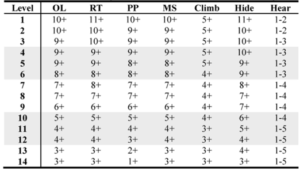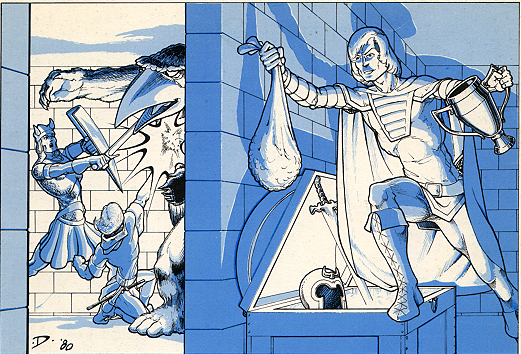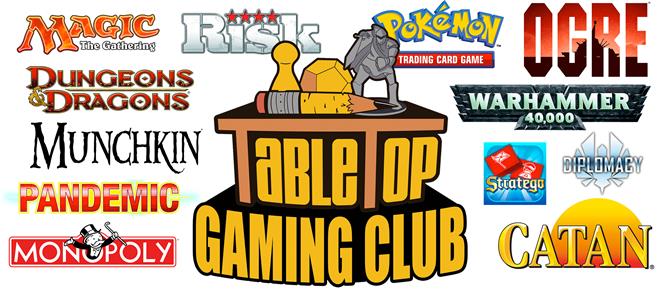 I design games, but that’s not my day job. These days, my mild mannered, not-so secret identity is that of a Middle School Technology and Game Design teacher. I also run the after school Tabletop Game Club, initiating young’uns into the mysteries of games that don’t require a tablet, phone or computer (and, yes, that logo is a modified version of Wil Wheaton’s Tabletop logo, that I made for the club).
I design games, but that’s not my day job. These days, my mild mannered, not-so secret identity is that of a Middle School Technology and Game Design teacher. I also run the after school Tabletop Game Club, initiating young’uns into the mysteries of games that don’t require a tablet, phone or computer (and, yes, that logo is a modified version of Wil Wheaton’s Tabletop logo, that I made for the club).
Recently, I was asked by some of my club kids to run D&D for them. A couple had heard of it, and one had played an abortive game of 5E, but they were really curious about the old B/X set that I have sitting on the bookshelf behind my desk, and really interested in knowing how it was done ‘back in the day.’
Now, at first I was hesitant. I had already gotten the ‘Parent Concerned over D&D’ letter earlier in the year, for teaching my game design students about the historical context of the game. We didn’t play the game in class, I simply taught them how it not only influenced modern game design, but (along with Star Wars) moved fantasy and science fiction from the backwater kingdom of the nerd and into the mass media arena of popular entertainment. I did use it to teach them how procedural generation worked, why we use it, and where it originated, using the random dungeon, wilderness and encounter tables, but having them generate content is a far cry from having them play the game.
Still, class is class, and game club is game club, so I told them I’d run it for a little while, until they got the hang of it, and then let them take over.
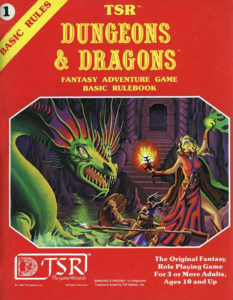 WHICH VERSION TO USE?
WHICH VERSION TO USE?
There are dozens of versions of D&D out there when you count the originals, retro-clones, neo-clones, restatements, etc., but one thing was certain: no matter which version I used, we were going back to my old school (no Steely Dan reference intended): descriptive based play, with minimal rolling, and a healthy dose of DM fiat (or ‘Rulings not Rules,’ as the kids are calling it these days). In the end, though, I went with my favorite version: B/X.
Now, to get the full effect of the rules differences, I initially planned to run it RAW, but that was quickly abandoned as an absurd idea, since that really isn’t how the game was played. Ever, as far as I can tell. The beauty of the Basic series over the Advanced series was that it wasn’t locked into Gary’s vision of an FRPG Rosetta Stone that was to be strictly adhered to. It was a crazy DIY toolbox in the spirit of the original 1974 version, which is probably why, even though we added bits from the Advanced rules into it here and there, we stuck to the boxed sets as our primary rules source.
That being said, I didn’t want to go overboard until what we were playing was an unrecognizable Frankenstein’s monster of a game (even though the kids would never know, as they don’t have to know thing one about the rules to play). So I stuck with the few house rules I consistently insist on, to cover the few warts the game presents for me.
 THIEVES & THEIR SKILLS
THIEVES & THEIR SKILLS
I have a real dislike for percentile rolls. I understand that it is the best way to represent chance in the most direct fashion, but the thing that bothers me about it is the ‘ones’ die. If there were ever a perfect analog example of video game ‘Pixel Bitching,’ that is it. You already have the pass/fail of the Tens die (50% chance, did I roll over or under a 5?), but that isn’t the end of it, as you have to now pass a second die roll (I have a 55% chance, I passed the tens roll, now I have to roll under/above a 5 on the ones die). I don’t find missing my roll by a percentage point to be particularly dramatic. In fact, I find it highly annoying.
And B/X D&D makes it worst by starting off thieves with a ridiculously low probability for passing their rolls (except for Climb). So to remove traps, I have to roll a 1 on one die, and a 0 on the next. And even at level 3, when characters are finally hardy enough to actually have a better than average chance of surviving the slings and arrows of outrageous misfortune, the poor thief still has to roll a 2 or less on one die, and a 5 or less on the other. And in exactly that order.
Never have the ‘wages of sin’ been more clearly demonstrated then by the B/X thief, who is usually the first to die in the performance of his ‘profession.’ A perfect example of this can be found on page B59, as Black Dougal fails to find a poisoned needle trap, fails his save, dies, and has his body unceremoniously looted by his former party members, all in quick order.
BECMI is even worse in this regard, as it takes the 14 level stretch from 10% to 99% and extends it over 36 levels! Thieves show almost no improvement for level gain as a result. I hated playing thieves in BECMI.
I prefer a single roll, with simple numbers. Multiple dice are okay, so long as they are summed in some way, to create a nice bell curve. I like bell curves, because I like the idea that there is a middle level of ability where the apprentice goes from failing most of the time, to succeeding on average, and then becoming even more capable as they rise in level, as opposed to straight increments of success, as given by a single D20, or the grinding progression of the percentile rating. So I converted the probabilities for Thieves skills to 2D6 (with the exception of Hear, which remains 1D6).
This progression, which is loosely based on the original percentile progression, solves my problem and allows for a couple of other considerations, which help to make the thief more interesting for the player, and the DM.
First, the new progression provides the proper range to allow thieves to apply Ability Bonuses to their rolls. A Level 1 thief with a Dexterity bonus of +2, would need to roll an 8+ to succeed, for example. And I can determine which ability applies on the fly. So if they are picking a lock, and I determine that bypassing this particular lock is more about brute strength, they apply their Strength bonus instead.
I can also make the task easier or harder by adding or subtracting D6s to the roll instead of 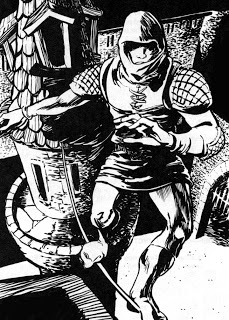 messing about with +/- modifiers (especially fiddly percentile ones). A particularly fiendish lock, made by a master gnomish locksmith for a special door, might reduce the number of dice rolled to 1, requiring a level 5-9 thief (depending on Dex bonus) to open! Or, if a thief is trying to hide in large, dark cave, with lots of nooks, stalagmites, and other cover, I might allow them to roll 3 dice, so the average roll becomes 11, giving even a 1st Level thief an average chance of success.
messing about with +/- modifiers (especially fiddly percentile ones). A particularly fiendish lock, made by a master gnomish locksmith for a special door, might reduce the number of dice rolled to 1, requiring a level 5-9 thief (depending on Dex bonus) to open! Or, if a thief is trying to hide in large, dark cave, with lots of nooks, stalagmites, and other cover, I might allow them to roll 3 dice, so the average roll becomes 11, giving even a 1st Level thief an average chance of success.
Besides changing the progression system, I also treat most Thief skills as a kind of ‘Bonus Saving Throw.’ Because I expect thief players to use their descriptive skills to find things, we rely on that first and foremost. I even allow them to find things that normal folks would miss, without need to roll. For example, if the thief player says, ‘I’m checking the underside of the door handle,’ I would reveal any visible things, like needles, and even some things others wouldn’t notice, like a dark resin like substance (contact poison) on the underside.
If they fail to check for a trap, say walking over a pit without knowing it, they get to roll their Find/Remove Traps skill to ‘notice’ it at the last moment. If they fail that, normal saves apply. This takes some of the weight off of the descriptive play, by allowing the thief to walk around without checking every square foot of floor in fear. Very useful, especially for new players, who are just getting the hang of things, or old hands who are comfortable relying on their character’s ‘intuition,’ especially at higher levels.
NEXT…
The post is getting long, but in the next one, I’ll detail a couple of other, shorter, changes to the system, and relate how my Middle School group handled their first foray into The Lost City…

